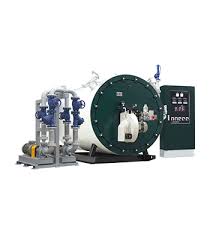
Nov . 07, 2024 13:09 Back to list
Schematic Representation of Hot Water Boiler Heating System for Efficient Thermal Management
Understanding Hot Water Boiler Heating Systems A Comprehensive Diagram Analysis
Hot water boiler heating systems are prevalent in residential and commercial buildings, known for their efficiency and reliability. These systems employ a simple yet effective mechanism to deliver warmth and comfort through radiant heat. To better comprehend the workings of a hot water boiler heating system, we can examine a typical diagram that outlines its key components and operations.
Core Components of a Hot Water Boiler System
A hot water boiler heating system primarily consists of several critical components the boiler itself, the pump, the heat exchanger, the piping, and the radiators or heating units. Each part plays a crucial role in the overall function of the system.
1. Boiler The heart of the system is the boiler, where water is heated. This can be achieved through various fuel sources, including natural gas, propane, oil, or electricity. The boiler's primary function is to convert these energy sources into heat, raising the water temperature to a level suitable for heating purposes.
2. Pump Once the water is heated, it is pumped through the system. The pump is essential for circulating the hot water through the piping and ensuring that it reaches all designated areas, such as radiators or underfloor heating systems, effectively distributing warmth throughout the building.
3. Heat Exchanger In some systems, a heat exchanger may be used, allowing the hot water to transfer its heat to the air or other fluids without mixing. This is particularly useful in more complex heating systems that may involve multiple heating methods or zones.
4. Piping The network of pipes connects the boiler to different heating units. These pipes are typically insulated to minimize heat loss as the hot water travels through them, ensuring maximum efficiency in the heating process.
5. Radiators/Heating Units Finally, the heated water reaches the radiators or other heating units, where it releases its warmth into the space. Radiators can come in various forms, including traditional steam or hot water radiators, baseboards, or underfloor heating systems. The choice of heating unit often depends on the specific requirements of the space and personal preferences.
The Heating Cycle Explained
hot water boiler heating system diagram

The operation of a hot water boiler heating system can be summarized in a continuous cycle
1. Heating the Water The cycle begins when the thermostat signals the boiler to activate. The burner ignites, heating the water in the boiler.
2. Circulation of Hot Water As the water reaches the desired temperature, the pump activates, circulating the hot water through the piping system to the radiators.
3. Heat Distribution The hot water enters the radiators, where it radiates heat into the room, warming the air and surfaces around it. As the water cools, it returns to the boiler through a separate return pipe.
4. Re-Heating The cooled water feeds back into the boiler, where it is reheated, and the cycle continues until the desired indoor temperature is achieved.
Benefits of Hot Water Boiler Systems
Hot water boiler heating systems offer several advantages. They are generally more energy-efficient than traditional heating methods, as they provide consistent and comfortable heat. Additionally, they tend to operate more quietly compared to forced air systems, making them an attractive option for many homeowners.
Moreover, the zoning capabilities of hot water systems allow for personalized heating in different areas of a building, enhancing both comfort and energy savings. With the ability to control the temperature in various zones, users can manage energy consumption more effectively.
Conclusion
A hot water boiler heating system represents a sophisticated blend of technology and design aimed at delivering reliable and efficient heating solutions. By understanding the components and operation of such systems through diagrams, one can appreciate the intricate workings that contribute to the comfort and warmth of our living and working spaces. As energy efficiency and comfort continue to be prioritized in modern building design, hot water boiler heating systems will undoubtedly play a significant role in shaping our environmental and residential landscapes.
-
High-Efficiency Commercial Oil Fired Steam Boiler for Industry
NewsJul.30,2025
-
High-Efficiency Biomass Fired Thermal Oil Boiler Solutions
NewsJul.30,2025
-
High Efficiency Gas Fired Thermal Oil Boiler for Industrial Heating
NewsJul.29,2025
-
High-Efficiency Gas Fired Hot Water Boiler for Sale – Reliable & Affordable
NewsJul.29,2025
-
High Efficiency Biomass Fired Hot Water Boiler for Industrial and Commercial Use
NewsJul.29,2025
-
High-Efficiency Biomass Fired Hot Water Boiler for Industrial Use
NewsJul.28,2025
Related PRODUCTS






















